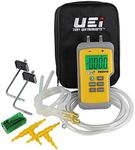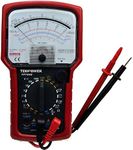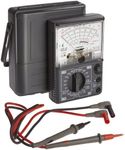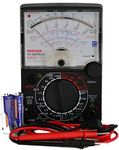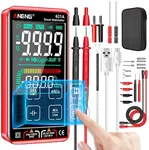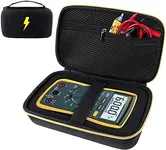Buying Guide for the Best Analog Multimeters
Choosing the right analog multimeter can be a bit overwhelming, but with the right approach, you can find the perfect fit for your needs. Analog multimeters are essential tools for measuring electrical values such as voltage, current, and resistance. They are favored for their ability to show trends and fluctuations in readings, which can be crucial for certain applications. To make an informed decision, you should consider several key specifications that will determine how well the multimeter will perform for your specific tasks.AccuracyAccuracy refers to how close the readings of the multimeter are to the actual values. This is important because precise measurements are crucial for diagnosing and troubleshooting electrical issues. Accuracy is usually expressed as a percentage. For general use, an accuracy of ±3% is often sufficient. For more critical applications, you might need a multimeter with higher accuracy, such as ±1%. Consider what level of precision you need based on the tasks you will be performing.
RangeThe range of a multimeter indicates the maximum and minimum values it can measure for voltage, current, and resistance. This is important because it determines the scope of measurements you can perform. Multimeters typically have multiple ranges for each type of measurement. For example, voltage ranges might include 0-10V, 0-100V, and 0-1000V. If you are working with household electronics, a lower range might be sufficient. For industrial applications, you might need a multimeter with higher ranges. Choose a multimeter with ranges that cover the values you expect to measure.
SensitivitySensitivity refers to the smallest change in measurement that the multimeter can detect. This is important for detecting small fluctuations in electrical values. Sensitivity is often expressed in terms of the smallest unit the multimeter can measure, such as millivolts (mV) or microamps (µA). Higher sensitivity is beneficial for detailed analysis and troubleshooting. If you need to measure very small changes, look for a multimeter with high sensitivity. For general use, moderate sensitivity is usually sufficient.
DurabilityDurability refers to how well the multimeter can withstand physical wear and tear, as well as environmental factors like dust and moisture. This is important because a durable multimeter will last longer and perform reliably in various conditions. Durability can be assessed by looking at the build quality and materials used. If you plan to use the multimeter in harsh environments, choose one with a rugged design and protective features. For occasional use in controlled environments, standard durability may be adequate.
Ease of UseEase of use refers to how user-friendly the multimeter is, including the readability of the display, the simplicity of the controls, and the clarity of the instructions. This is important because a multimeter that is easy to use will save you time and reduce the likelihood of errors. Look for a multimeter with a clear, easy-to-read scale, intuitive controls, and comprehensive instructions. If you are a beginner, prioritize ease of use to ensure you can operate the multimeter effectively.
